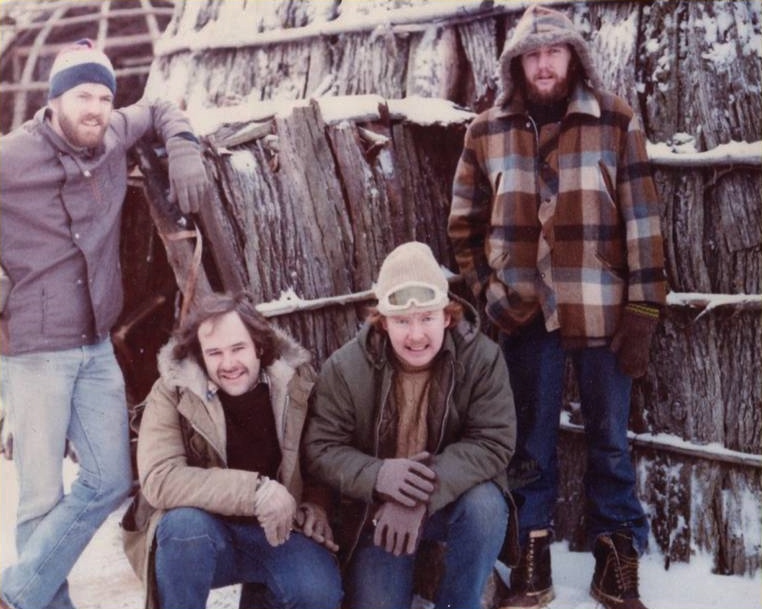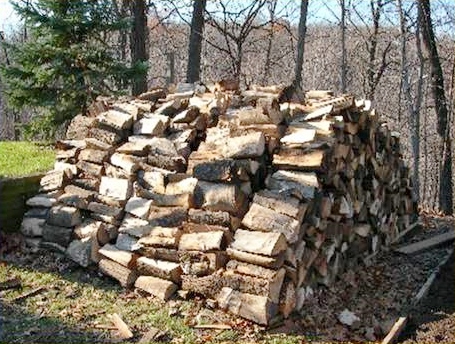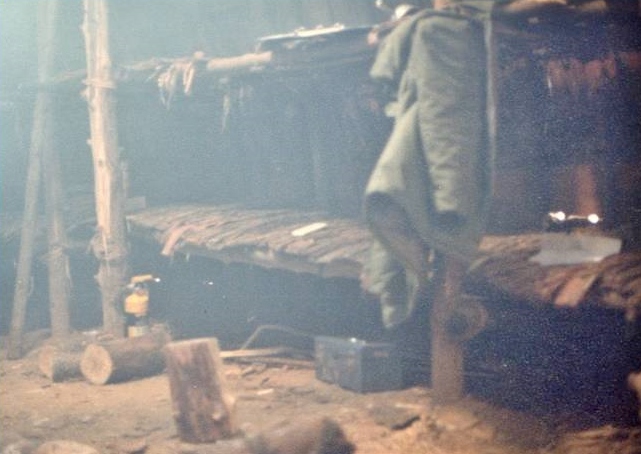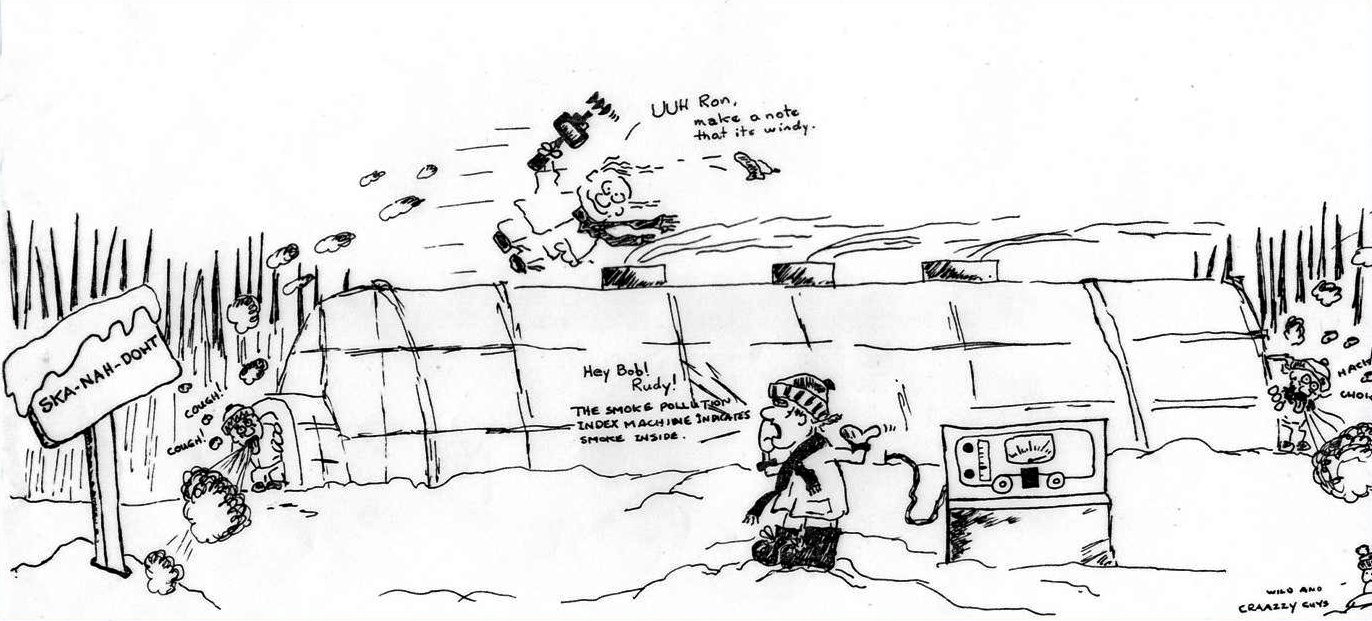Winter is coming. We thought we would share with you what it’s like to live in a really, really cold longhouse – and also what it’s like to be surrounded by smoke the entire time. Next time you complain about the brisk autumn weather, think of this 1979 winter longhouse project and feel a bit warmer.
[line]

How much firewood did Iroquoian peoples use in the winter?
This question was one of the reasons why Ron Williamson, David Smith, Rudolphe Fecteau and Robert Pearce moved into a Ska-Nah-Doht longhouse, located in the Longwood’s conservation Authority Area near Delaware, Ontario, on January 3rd, 1979. They lasted 30 hours.
The following account is derived from a paper delivered by the lads and a Kewa article later that year. Rudy Fecteau is the keeper of the archive and has given a number of presentations over the years about the experiment – probably because he drank less scotch and his memory of the 30 hour period is more complete.
Iroquoian peoples relocated their villages periodically for many reasons. Soil nutrient depletion, pests, scarcity of firewood, fear of enemy attack, and other variables contributed to this major decision. Both Sagard and Brebeuf mention in their ethnographic accounts that firewood was a reason for the movement of ancestral peoples. Sagard’s accounts contain the only reference to actual firewood quantity, stating: “they use only very good wood, preferring to go for in search of it rather than to take green wood or what makes smoke; for this reason they always keep up a clear fire with a small quantity of fuel” (Sagard 93-95). The need for (and depletion of) firewood was a variable that this team thought needed to be explored through “experimental archaeology.” And so, armed with this question, the participants set off into the longhouse to begin the experiment.

The longhouse the participants stayed in measured 21.3 m long, 6 m wide and 4.5 m in height. The frame of the house was covered by a double layer of elm bark with plastic sheeting between the two layers to aid in insulation. The doorways at either end of the longhouse were covered by canvas measuring about 2 x 1 metres. A total of four smoke vents (measuring .4 m in diameter) lined the top of the house with hinged covers, allowing them to be opened with a pole from the inside. Finally, there were five centrally aligned hearths that were all used at one point or another during the project.
With a temperature of -15 degrees Celsius and gusts up to 40km/hour, the temperature felt like -34 degrees Celsius with the wind chill during the 30-hour project.
In total, the participants used 35% pine, 28% ash, 21% maple, 10% beech and 6% walnut of 436.3 kilograms of wood. This represented the significant amount of wood for a thirty hour period. During the maintenance of the fires, they recorded temperatures from around the house. Not surprisingly, the upper bunks generally recorded temperatures 2 degrees Celsius warmer than those of the lower bunks.

With two fires roaring during the day, the inside temperature at 3 PM reached only -5 degrees Celsius. By 5 PM with three fires going, the temperature was up to 7 degrees Celsius and at 8 PM, a maximum temperature of 12 degrees Celsius with four fires in full blaze was achieved.
By about midnight, the researchers realised that original longhouse occupants probably used less wood than they were using, by maintaining fires at the hot ember and coal stage a great part of the time. Thus, the participants maintained four hot ember fires with an inside temperature ranging between 0 and 2 degrees Celsius. Visitors to the experiment felt quite cold, but the four men got used to the temperatures and more or less acclimatised to the environment – the scotch definitely helped.
As their bodies were adjusting to the temperature by the second day, it was clear that the smoke was the real problem.
Throughout the experiment we maintained a smoke level at about 3’ to 5’ above ground level. Borrowing a measuring tool from the University of Western Ontario, they measured the smoke density, as well as the amount of haze and sulpher dioxide in the air.
Two of the most important factors involved in the severe smoke discomfort were the height of the house and the smoke covers. A 20 foot height would have been more appropriate to facilitate the smoke upwards. Secondly, the covers were hinged which did not help to draw the smoke out of the house, so the smoke was bellowing back into the house. (Cough, cough.)

The researchers actually suffered smoke inhalation symptoms. They complained initially of post-nasal drip and sore eyes, using ski goggles to help keep eyes clear. They later experienced lung congestion, followed by headaches and nausea. They explained that “these symptoms characterize a state where there is less than 16% oxygen in the air and carbon monoxide is prevalent in the bloodstream.” That they experienced this is not all that surprising. Detailed study of the remains from the Moatfield ossuary revealed that about 60% of the population had suffered from maxillary sinusitis, most of which could likely be related to chronic exposure to smoky wood fires.
So, what did they conclude?
Obviously, to minimise this problem, houses would have been completely sealed at both ends and along its walls to ensure no disruptions to the upward flow of the smoke from the fire and a height of at least 20 feet would have allowed proper convection. The body temperature of more than four people would also have significantly raised the temperature and lowered the amount of wood used. The greater the heat, the better the convection and the rising of smoke.
In the end, the participants suggested that should someone want to try this experiment again, it should be conducted “over an extended period of time, perhaps a month, with an appropriate number of people and demanded the search for volunteers be limited to those with no previous experience!”



